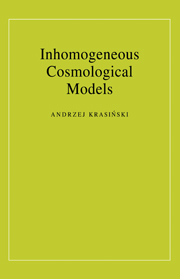Book contents
- Frontmatter
- Contents
- List of illustrations
- Preface
- Acknowledgements
- 1 Preliminaries
- 2 The Szekeres–Szafron family of solutions
- 3 Physics and cosmology in an inhomogeneous Universe
- 4 The Stephani–Barnes family of solutions
- 5 Solutions with null radiation
- 6 Solutions with a “stiff fluid”/scalar field source
- 7 Other solutions
- 8 Averaging out inhomogeneities of geometry and matter in cosmological models
- 9 Comments
- Appendix A Dictionary of abbreviations used in the text and in the diagrams
- Appendix B Why should one consider inhomogeneous models of the Universe?
- Appendix C Memorable statements about the cosmological principle
- Appendix D How was this review compiled?
- Appendix E Historical milestones
- Notes added in proof
- Bibliography
- Index
Appendix B - Why should one consider inhomogeneous models of the Universe?
Published online by Cambridge University Press: 03 May 2010
- Frontmatter
- Contents
- List of illustrations
- Preface
- Acknowledgements
- 1 Preliminaries
- 2 The Szekeres–Szafron family of solutions
- 3 Physics and cosmology in an inhomogeneous Universe
- 4 The Stephani–Barnes family of solutions
- 5 Solutions with null radiation
- 6 Solutions with a “stiff fluid”/scalar field source
- 7 Other solutions
- 8 Averaging out inhomogeneities of geometry and matter in cosmological models
- 9 Comments
- Appendix A Dictionary of abbreviations used in the text and in the diagrams
- Appendix B Why should one consider inhomogeneous models of the Universe?
- Appendix C Memorable statements about the cosmological principle
- Appendix D How was this review compiled?
- Appendix E Historical milestones
- Notes added in proof
- Bibliography
- Index
Summary
For most physicists, sufficient reason to consider the Universe as being inhomogeneous is the intellectual challenge to explore the unknown. A mathematical argument in favour of inhomogeneous models was given by Tavakol and Ellis (1988). The authors demonstrated on examples that including new parameters (or changing values of parameters) in a set of ordinary differential equations may drastically change the behaviour of solutions, for example, from periodic to chaotic. This shows that the set of cosmological models is most probably structurally unstable. Tavakol and Ellis emphasized the importance of studying models without symmetry.
Several physicists were already able to see in the 1930s that the “cosmological principle” was not a summary of any kind of knowledge, but just a working hypothesis leading to the simplest models that were yet acceptable. A sample of early reservations about the cosmological principle is given in Appendix C. Unfortunately, the astronomical community was largely unconvinced. The discoveries of large inhomogeneities in the 1970s and 1980s were met with surprise. By the present day, those same discoveries could be sufficient argument for considering inhomogeneous models, and the idea seems to be gaining still wider acceptance (see an interesting proposal by Melott, 1990, to measure the topology of large-scale matter distribution in the Universe). However, over the years, astrophysical and philosophical arguments have been given by several authors in favour of generalizations of the FLRW models, and they are briefly recalled here. The collection does not pretend to be complete.
- Type
- Chapter
- Information
- Inhomogeneous Cosmological Models , pp. 279 - 283Publisher: Cambridge University PressPrint publication year: 1997

